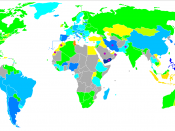What control is the state able to exert over sexuality, and how is this done? Discuss with reference to homosexual identity for young people.
Discrimination remains a reality for members of the gay, lesbian, bisexual and transgender (GLBT) communities in NSW. Homophobic prejudices that fuel this discrimination are often unfounded but draw strength from the discriminatory law itself. This essay is going to analyze how the state exerts control over GLBT people and what this entails for the GLBT community. But before looking at how the NSW government excludes members of the GLBT community from fundamental human rights, this essay is going to discuss how homophobia arose in the first place.
Given the fact that Christian beliefs are deeply embedded in Australian society it is obvious that the Church contributed to the formation of homophobia. For thousands of years the church had been instructing society on what was moral in sexual matters and homosexuality was not on their list.
Homosexual attitudes were regarded as absurd and seen as a crime against nature. In 1977, Anita Bryant, an anti-gay campaigner said that "God created Adam and Eve, not Adam and Steve", adding that "homosexual acts are contrary to the laws of nature and the protesters must realize that the Church's teaching on this matter cannot, and will not change". The Church's current standpoint on this matter is that members of the GLBT community are 'tolerated', but only if they are 'discreet'. However, Bishop Benjamin Tutu of South Africa once pointed out that homosexuality cannot be a matter of choice. Who would select a life style that would bring such hatred, abuse and discrimination against them?
On the other hand, homosexuality has been a tolerable practice within Christianity for centuries. Michelangelo and Leonardo da Vinci were famous homosexuals, and religious personalities. Where...


